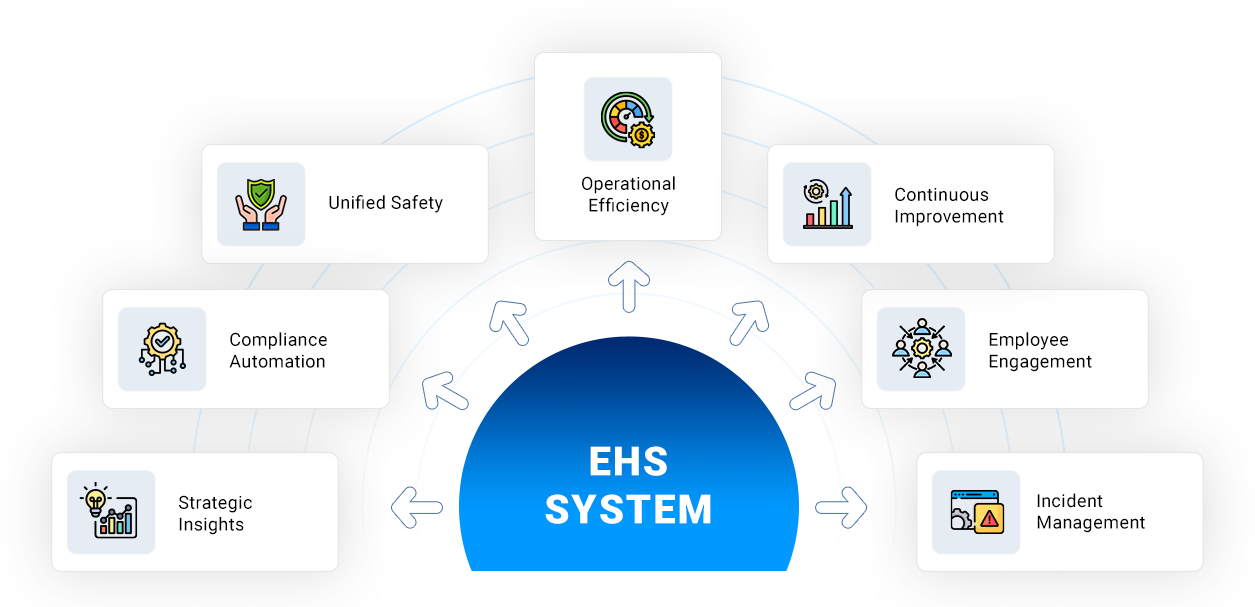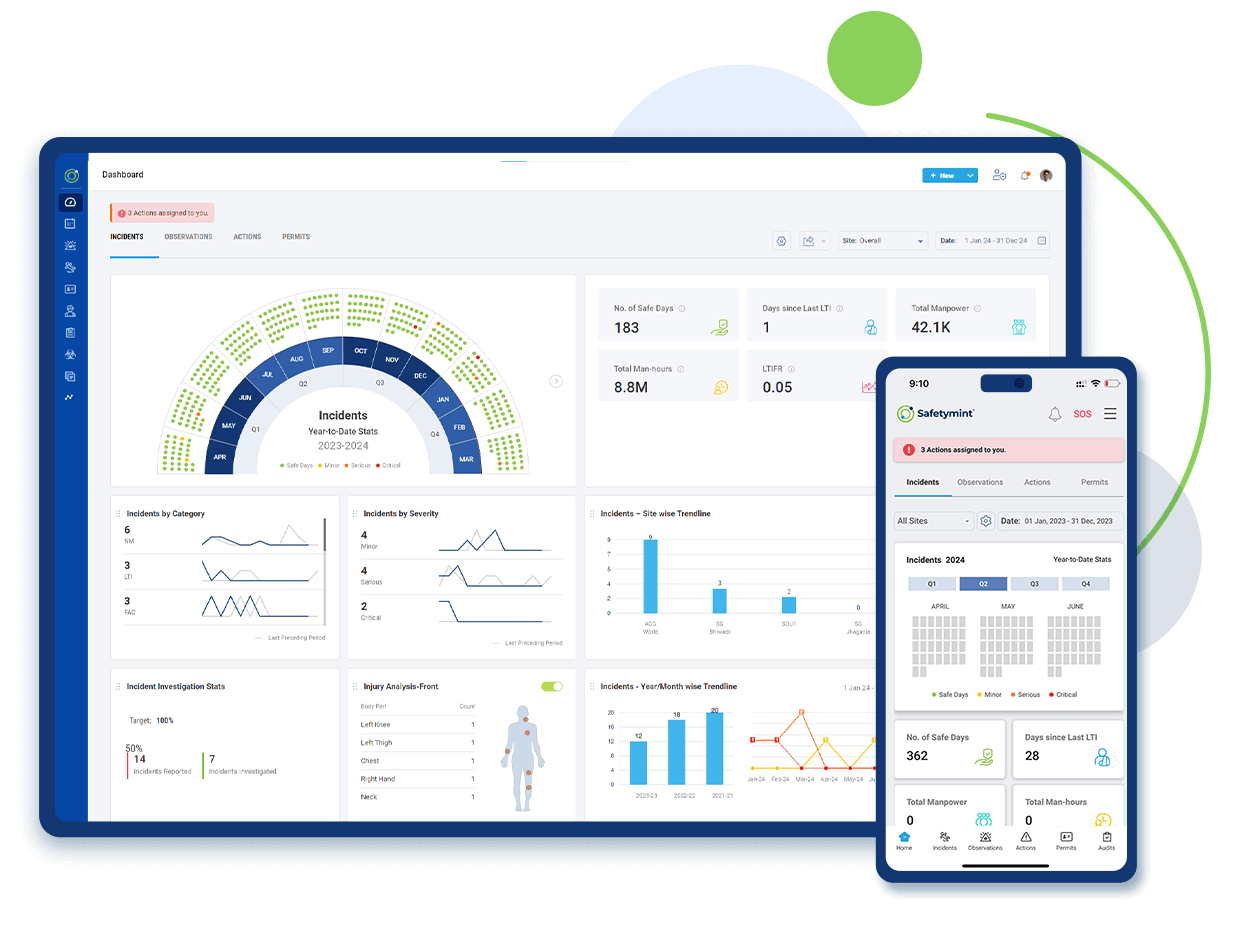What is EHS (Environment, Health and Safety)?
Defining EHS:
Environment, Health, and Safety (EHS) is a system designed to
ensure that organizations adhere to regulations, prevent
workplace incidents, and promote a healthy and safe work
environment. The primary objective of EHS is to create a
compliant, safe, and efficient workplace. EHS technology aids
companies in managing risks, ensuring compliance, and enhancing
overall safety performance.
When discussing EHS, the reference is often to an EHS system:
software that manages and tracks incidents, observations,
near-misses, and compliance activities. This encompasses managing work permits,
performing audits and
inspections, tracking corrective and preventive actions (CAPA),
and more.
EHS tools consolidate data from multiple sources and leverage
advanced analytics to manage safety and compliance across the
organization. This includes departments such as operations,
safety management, compliance, and environmental
health.
Looking for an enterprise EHS solution?
With Safetymint, you get a flexible and customizable solution
that suits your business requirements.
Who is EHS for?
EHS software is designed for organizations across various
industries and sizes. It is advantageous for large corporations
that need a unified platform to track safety activities and
share information across departments, small businesses striving
to optimize their safety processes, and startups aiming to
implement efficient safety practices from the start. Regardless
of your sector, whether it be construction, manufacturing, oil & gas, mining, or even
non-profits, if your organization needs to manage safety and
compliance, EHS tools can provide substantial benefits.
Environment, Health, and Safety management software can be a
valuable asset to any department within your company, from
operations to compliance, human resources, and beyond. Whether
you aim to implement a comprehensive EHS software right away or start with
specific modules, getting started is more straightforward than
you might expect.
Why is an EHS System Important for Your Organization?
Managing a modern organization has become increasingly complex.
On average, companies use numerous applications to handle their
operations, but only a small percentage of these are integrated
efficiently.
To maintain a competitive edge, your organization needs to
prioritize safety and compliance, supported by the right
technology. However, obtaining accurate, up-to-date, and
actionable safety information can be challenging. How do you
transform the diverse streams of data from incident reports, compliance
checks, audits, and inspections into valuable
business insights?
An EHS solution is the answer. Here are several reasons why an
EHS
system is crucial for your organization:
A Unified Safety Platform
An EHS management system offers a comprehensive, unified view
of your safety data. It provides a single, secure, and
customizable dashboard where you can track
incidents, observations, near-misses, compliance statuses, and
corrective actions. This consolidated information is invaluable,
especially since all stakeholders need access to reliable safety
data to make informed decisions and maintain compliance.
Whether safety data comes from incident reports, audits, or inspections, a
unified platform ensures that everyone in your organization can
access the necessary information to ensure a safe and compliant
workplace.
Cost Efficiency
A centralized EHS system not only benefits safety management
but also enhances organizational efficiency. Teams across
departments generate substantial data during safety audits,
inspections, and incident investigations.
If this information is stored in disparate systems or not
recorded systematically, it can lead to significant cost
implications. Important details may be overlooked, action items
might not be addressed promptly, and safety priorities could be
misaligned. Moreover, when employees leave, crucial safety
knowledge and documentation might be lost.
An EHS system reduces administrative overhead and allows your
team to focus on proactive safety management and risk
mitigation.
Integrating All Departments
An EHS system connects various departments, facilitating
seamless information sharing that simplifies everyone's tasks.
For instance, operations teams can utilize EHS tools to manage
safety protocols and ensure compliance. EHS software provides
visibility into every safety incident or observation, offering a
clear path from identification to resolution. Compliance teams
can manage regulatory requirements, while human resources can
track employee training and certifications.
Real-time Notifications and Alerts
An EHS system enhances organizational responsiveness by
providing real-time notifications and alerts. When an incident
occurs or a compliance deadline approaches, the system
automatically sends alerts to the relevant personnel. This
ensures that issues are addressed promptly and that all
stakeholders are kept informed. Real-time notifications help
prevent small issues from escalating into larger problems and
ensure that safety and compliance remain top priorities.
Continuous Improvement and Learning
An EHS system fosters a culture of continuous improvement by
providing tools for tracking and analyzing safety performance.
Features such as incident investigation, root
cause analysis, and lessons learned
repositories enable organizations to identify trends, uncover
underlying issues, and implement corrective actions. By
continuously learning from past incidents and near-misses, organizations can
improve their safety practices and reduce
the likelihood of future incidents, creating a safer work
environment for everyone.
By implementing an EHS system, your organization can enhance
safety performance, ensure regulatory compliance, and improve
overall operational efficiency.
How Can an EHS System Benefit Your Organization?

Implementing an EHS system offers numerous advantages for
organizations aiming to enhance safety, ensure compliance, and
improve overall efficiency. Here are some key benefits of using
EHS software:
1. Unify Your Safety Efforts
An EHS system enables seamless data sharing across various
departments within your organization. It provides a
user-friendly interface with real-time updates, allowing
everyone to access critical safety information. This integration
ensures that when a safety issue arises, all relevant teams have
the data they need to respond effectively. The EHS system can
also offer insights and recommendations based on trends and
analytics, enhancing collaborative efforts to maintain a safe
work environment.
2. Boost Operational Efficiency
Introducing an EHS platform can lead to significant
improvements in operational efficiency. It helps your employees
save time by streamlining safety processes, automating routine
tasks, and reducing the administrative burden. By using an EHS
system, organizations can unlock new opportunities for
improvement, ensuring that resources are allocated efficiently
and that safety measures are implemented effectively.
3. Enhance Employee Engagement and Retention
Understanding and addressing safety concerns is crucial for
employee satisfaction. An EHS system provides visibility into
safety practices and incident trends, allowing for proactive
measures to improve workplace conditions. By fostering a safer
work environment, employees are more likely to remain engaged
and committed, reducing turnover and increasing productivity.
4. Provide Superior Incident Management
Today's workforce expects prompt and personalized responses to
safety concerns. An EHS system enables your organization to
deliver high-quality incident management by maintaining
comprehensive records of all past interactions and incidents.
This ensures that safety personnel can quickly access relevant
information and provide informed solutions, enhancing overall
safety and compliance.
5. Drive Continuous Improvement
A robust EHS system collects data from various sources within
your organization, serving as a comprehensive tool for
monitoring safety performance. By analyzing this data,
organizations can gain insights into potential hazards, identify
areas for improvement, and implement preventive measures. This
continuous feedback loop helps in refining safety protocols and
maintaining a proactive approach to risk management.
6. Accelerate Compliance with Automation
EHS software streamlines complex safety processes through
automation, allowing employees to focus on higher-value tasks.
Automated workflows ensure that safety procedures are followed
consistently and that compliance requirements are met without
manual intervention. This not only improves accuracy but also
speeds up the resolution of safety issues, contributing to a
more efficient and compliant workplace.
7. Gain Strategic Insights with Analytics
Incorporating advanced analytics into your EHS system can
provide strategic insights that drive organizational growth.
Analytics tools can identify trends, predict potential risks,
and highlight areas of inefficiency. These insights enable your
organization to make data-driven decisions, optimize safety
practices, and uncover new opportunities for improvement. With
comprehensive analytics, you can enhance safety performance and
ensure long-term sustainability.
By leveraging an EHS system, your organization can create a
safer, more compliant, and efficient work environment. The
benefits extend beyond regulatory compliance, contributing to
overall operational excellence and fostering a culture of
continuous improvement.
What Does an EHS System Do?
An EHS system allows organizations to manage safety processes,
track incidents,
monitor compliance, and conduct audits and inspections all from
a centralized platform. It organizes safety-related data in a
secure, easy-to-use digital record that includes incident
reports, risk assessments, compliance documentation, and more.
This information is readily accessible to all relevant
stakeholders, ensuring that everyone has the information they
need to maintain a safe and compliant work environment.
EHS systems help organizations identify hazards, implement
corrective actions, and continuously improve their safety
practices. They can also use automation to collect data more
efficiently, keeping everyone up to date with the latest safety
information.
Key Features of an EHS System
EHS software provides organizations with tools that enhance
communication and streamline safety processes. Here’s how:
Flexibility, Security, and Cost Efficiency with a Cloud-based
EHS
Modern EHS software is hosted in the cloud, allowing secure
access to safety data from anywhere at any time. This means
every employee has access to real-time information and can make
updates from any location.
Moving to the cloud simplifies implementation and reduces
costs. There’s no need for hardware, which cuts down on
installation and maintenance expenses. IT teams benefit from
hassle-free version control and updates. Cloud-based EHS systems are
scalable, so you only pay for the seats and features you need,
and you can easily expand as your organization grows.
Cloud solutions have transformed EHS management by enabling
remote work, enhancing collaboration, and reducing costs, all
while offering robust security to protect your safety and
compliance data.
Comprehensive View of Safety Data
An EHS system provides a consolidated view of all
safety-related activities and interactions. For operations, this
means efficiently managing safety protocols and compliance
tasks. Safety managers can monitor incident trends, track
corrective actions, and ensure regulatory compliance with
greater accuracy.
Compliance teams can utilize EHS tools to conduct thorough
audits and inspections, while human resources can manage
employee training and certifications. This unified approach
ensures that every department has the information they need to
maintain a safe work environment.
Integration with Other Business Applications
Organizations often use numerous applications that don’t
always communicate with each other. An EHS platform can
integrate with other business apps, facilitating the flow of
information and creating a comprehensive safety management system.
EHS solutions can connect with tools for document management,
workflow automation, and reporting, providing a 360-degree view
of safety and compliance data.
Enhanced Incident Management and Response
EHS systems improve incident management by maintaining detailed
records of all safety incidents and observations. This enables
quick access to relevant information, allowing safety teams to
respond promptly and effectively. The system can automate
notifications and alerts, ensuring that critical issues are
addressed immediately.
Continuous Improvement and Learning
An EHS system fosters a culture of continuous improvement by
providing tools for tracking and analyzing safety performance.
Features like root cause analysis and lessons learned
repositories help organizations identify underlying issues and
implement corrective actions. By continuously learning from past
incidents, organizations can enhance their safety practices and
reduce the likelihood of future incidents.
How Much Does an EHS System Cost?
EHS systems offer significant benefits for organizations of all
sizes, but they don’t have to come with a hefty price tag. The cost
of an EHS system depends on the features, deployment
method (cloud or on-premise), and the size of the organization.
Typically, cloud-based EHS solutions offer flexible pricing
models, allowing you to scale the system as your needs grow.
Whether you’re a small business or a large enterprise, it’s
easy to get started with an EHS system that fits your budget and
requirements. By investing in an EHS solution, you can enhance
safety, ensure compliance, and improve overall operational
efficiency.


